Edward Thorndike's Connectionism Theory
In a report published in 1910 in The Journal of Educational Psychology, entitled “The Contribution of Psychology to Education”, Edward Thorndike –a prominent American psychologist- introduced a set of principles that would come to be known as Thorndike's Laws. According to these Laws, learning is achieved when an individual is able to form associations between a particular stimulus and a response. These are known as “habits”, and can either be encouraged or deterred by external parameters and the frequency an individual is exposed to the stimulus and the response.In a learning environment, Thondike's Laws highlight the importance of rewards and emphasize on the necessity of practice and repetition. More specifically, the Law of Readiness (see below) suggests that a teacher can only instruct a student if that student is willing to be educated. When a student does not show any signs of readiness, a teacher should provide instructions that will help the student develop.
Thorndike's Learning Laws
- Law of effect
An individual's response to a specific situation followed by a reward will eventually make those responses stronger. Therefore, the responses become habits when the individual is presented with that particular situation again. Additionally, if a response deters an individual from achieving a reward, or a “rewarding state”, then this response becomes weaker. - Law of readiness
A series or a set of responses can be linked together in order to achieve a goal. If the person is prevented from achieving this goal, this will cause “annoyance”. - Law of exercise
Frequently made associations become strengthened. Likewise, rare or sporadic associations become weaker.
Thorndike’s Learning Theory
Thorndike’s learning theory, however, consists of numerous additional laws:
- Multiple responses
In any given situation, an individual might react in a variety of ways if the initial reaction does not immediately lead to a satisfying result. - Set of attitudes
Individuals are inclined to react in a particular way. These reactions are unique for species or groups of related species. - Prepotency of elements
Individuals are able to filter out any irrelevant aspects of a particular situation and respond only to significant parameters that directly affect this situation. - Response by analogy
Reactions from a previously experienced situation might be transferred to a new one. This is also called Theory of Identical Elements. - Associative shifting
Sometimes, a reaction to a certain stimulus might shift to a different one.
Thorndike’s Connectionism Theory
Thorndike also suggested the Connectionism Theory, which is based on the ideas presented by associationism. In this theory, Thorndike hypothesized that certain elements become associated though a similar experience and that more complex ideas can be taught or explained through a series of simplified rules. In this theory, there are four key principles:
- Learning involves both practice and a reward system (based upon the law of effect).
- Stimulus and response associations can be linked if they are part of the same “action sequence” (based upon the law of readiness).
- The transfer of knowledge and learning is based on situations that have been previously experienced by the individual.
- Intelligence is determined by how many of these associations have been learned and/or acquired
Implement the most Impactful Instructional Design Theories with the Best Authoring Tool!Discover, choose and compare the top eLearning Authoring Tools Providers!
Join us at the Instructional Design History Journey
A New Instructional Design Model Will Be Added Every Week! You are more than welcome to let us know if you would like us to cover an instructional design model and theory that is not included at Instructional Design Models and Theories. Simply leave a comment at Instructional Design Models and Theories.
Last but not least, you are more than welcome to embed the Connectionism Theory presentation at your site of blog. If you have a question that needs an answer concerning the Connectionism Theory do not hesitate to leave a comment and I will reply you as soon as possible.
References
- Medler, David A. A Brief History of Connectionism. Neural Computing Surveys, 1(2), p18-72. 1998.
- Reinemeyer, E. Edward Lee Thorndike. Muskingum University. May 1999.
- Zimmerman, Barry J. and Schunk, Dale H. Educational psychology: a century of contributions. Routledge, 2003.








